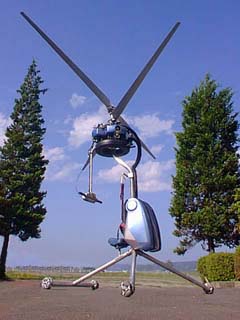 Ok, "This is one of the strangest things I've seen on the net today!" you are probably thinking to yourself, but what is it you ask?
Ok, "This is one of the strangest things I've seen on the net today!" you are probably thinking to yourself, but what is it you ask?It's the "GEN H-4." The world's smallest co-axial helicopter ever made!
This is a Japanese designed and manufactured ultralight one-man helicopter. The total empty weight of this helicopter is only 155 lb.
Yes, you're right it is a quite interesting contraption! It is true that there is not much to see on the outside. The frame is 2 inch aluminum pipe bent and welded, with a fiberglass backpack and funny looking wheels. The controls are direct, like many gyrocopters. In front of the pilot attached to the control bar is the control panel with the throttle (altitude control), tachometer, ignition power, starter and yaw switches. The tools necessary for flight do not seem like much because they aren't. This is not only the lightest helicopter in the world, but it is the easiest to fly!
If you look closely at the power pack (on top of the air craft) you will find four astonishingly small twin cylinder engines feeding into a central transmission with two sets of rotors turning in opposite directions. Wow, you say? That's nuts!.


